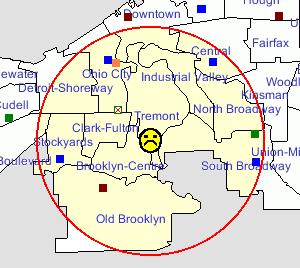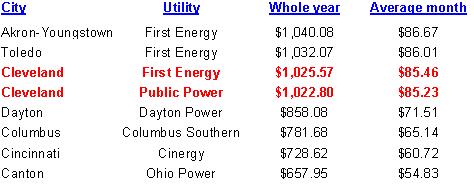This Steelyard Commons marketing site, caught Tuesday by Jeff Hess, makes the whole thing pretty clear. SYC is a "regional power center serving an untapped trade area with no competition... This development will create a new regional trade area in a previously underserved and impenetrable market."
What's this "untapped trade area with no competition"... this "impenetrable market"? For the answer, take a look at this city neighborhood map with a three-mile circle drawn around SYC, represented, naturally, by a frownie-face.

You can see that this circle includes all or most of nine neighborhoods (not counting downtown and the Industrial Valley). Each of these neighborhoods (Old Brooklyn, Brooklyn Centre, Stockyards, Detroit-Shoreway, Ohio City, Clark-Fulton, Central, North Broadway and South Broadway) has its own community development corporation, or shares a CDC with the area next door. Each of these CDCs has a longstanding commercial development program focussed on preserving and expanding local shopping opportunities in one or more retail nodes. In most of these programs, neighborhood food markets -- i.e. small to mid-sized supermarkets -- play an essential role as local amenities and anchors for other local shopping.
The little colored squares on the map are those food markets. Blue squares are Dave's Supermarkets, green squares are Tops Markets, brown squares are independents. The orange square in Ohio City is the West Side Market. I haven't included discount groceries like Aldi's, but Brooklyn Centre, Detroit-Shoreway and Broadway have those, as well. The square with the "x" in Clark-Fulton is the recently closed Tops on Clark Avenue -- which would be the subject of a neighborhood crusade right now, if it wasn't for the Wal-Mart SuperCenter looming just over the hill. Where you see a colored square, there is almost certainly a larger "local retail" node that's been nursed, marketed and invested in -- by the local CDC, by the City, by the foundations through Neighborhood Progress -- for ten, fifteen or even twenty years.
The business plan of Steelyard Commons is to pull lots of the local customers away from neighborhood retail nodes, effectively wiping them out. That's not scare talk... it's a simple statement of obvious fact. SYC's big anchor is Wal-Mart, and Wal-Mart wouldn't play unless it could sell food. The principal market area for a SuperCenter is generally described as two miles around for food, and five miles around for other goods (that's why so many small cities are seeing one built at each end of town). Who are the "untapped, impenetrable" customers for Wal-Mart in that magic circle? They're the people now shopping at Dave's, the Bi-Rite on Fulton, Gillombardo's Tops on Broadway -- the local shoppers who make those local retail strips sustainable.
By supporting -- pushing, celebrating -- this SYC/Wal-Mart business plan, the Campbell Administration is abandoning the City's twenty-year commitment to food-anchored neighborhood shopping districts in these and (eventually) other neighborhoods. The Mayor will hotly deny this, of course, but there's really no other rational interpretation that fits the facts.
The circle on the map is a retail blast zone, and City Hall is escorting Wal-Mart to the launch button.
Why is this not a fighting issue for even one of Campbell's opponents? There you have the great mystery of this election year.





